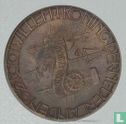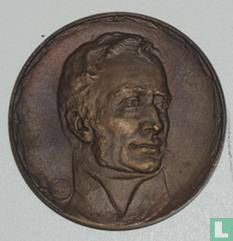





Catalogue information
Commemorative medal from 1840 In 1813 the Batavian-French period (1795-1813) came to an end. The French have been expelled; our country is free again. The son of Stadtholder William V, who fled in 1795 and who has since died, returns to his homeland from England. William I becomes King of the Netherlands. Prince Willem VI was enthusiastically greeted by the Dutch people on his return home on November 30, 1813. He accepts the government as sovereign and is later crowned King William I. As is customary in the production of coins, new designs for coins are made when the new monarch takes office. Some coins feature the portrait of William I, others a crowned letter W. These are the first coins of the Kingdom of the Netherlands. Congress of Vienna After the fall of Napoleon Bonaparte, Europe must be reorganized. From 1815 onwards, the Congress of Vienna started to deal with this thorny question. The Congress proclaims, among other things, the Kingdom of the Netherlands and assigns William I, in addition to Belgium, the Grand Duchy of Luxembourg. A new constitution was drawn up which, except for the revision of 1848, is still valid today. William I broadly continues French policy and rules this empire as an enlightened absolutist. Economy Willem also wanted to give the economy a new impulse and founded, among other things, De Nederlandse Bank (1814), to lend money to people who wanted to set up their own industrial company. And in addition there were other initiatives to combat poverty among workers, such as the foundation of the Nederlandse Handel Maatschappij (1824). To improve access to the country and to create employment, various canals - the Noordhollands Canal - were dug, important trade roads were paved and the first railway lines were constructed. Belgium However, the integration of the Northern Netherlands and the Southern Netherlands (Belgium) went poorly. The Catholic Belgians were not too happy with the Protestant monarch and his self-serving actions were not appreciated. In the summer of 1830, the revolution against King William I broke out in Brussels. The Ten-Day Campaign of 1831 was successful but ultimately could not prevent Belgium from becoming an independent Kingdom. Belgium was recognized as a kingdom by William I in 1839. In 1840 Willem I resigned and was succeeded by his son Willem II. Nice to know: Soester tubers King William I is very fond of Soester tubers. The tubers are known for their delicious taste, which was on the menu of farmers, citizens, nobility and therefore also kings in the autumn. His favorite recipe is Soester tubers with mutton. The dish is even given a political touch. During the kingship and even after the abdication of William I - when the king has lost popularity - orange-minded families eat his favorite dish on March 8, Willem's birthday. As a token of appreciation and to show their aversion to the changes dating back to the Batavian-French era. Source: Nieuwekamp, J.F.K., 'Soesterknollen, a royal dish', from: Oud-Utrecht, monthly magazine, 1966, pp. 77 -79.
This text has been translated automatically from Dutch
Click here for the original text





